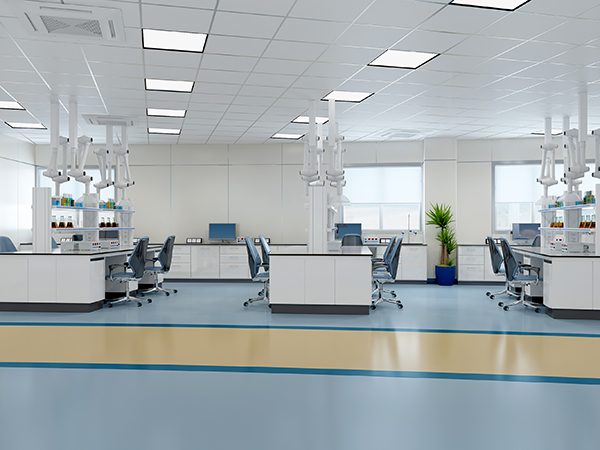Search
Search
Phone
Call
Mobile

Laboratory construction is a systematic project involving long periods, budget constraints, site constraints, geographic location, and climate Many factors such as characteristics require systematic and closed-loop thinking and concepts. As the saying goes, sharpening the knife and not cutting the material by mistake, the laboratory construction needs to lay a good foundation in the laboratory design stage in advance, so as not to appear in the decoration stage, the acceptance stage, the use stage, and even the later maintenance stage. The sequelae of human headaches, I believe that many laboratory managers have had similar failure experiences.
So what factors should a good laboratory design plan pay attention to?
1. Laboratory layout design;
The layout design of the laboratory is based on the nature of the laboratory, the target positioning of the laboratory, the functional requirements of the laboratory, the type of experiment, and the experimental process flow, etc., according to the relevant national standards for the existing site of the laboratory to be scientific and reasonable The work of distinguishing between functions and layout.
Laboratory graphic design requires laboratory designers to be familiar with my country's architectural decoration knowledge, my country's laboratory related standards and specifications, and the laboratory experimental process flow designed.
2. Laboratory area and equipment placement;
Before the laboratory design, the type, quantity, specifications, model, size, voltage, power and other parameters and placement of the instrument should be determined according to the experimental process, and the designer should make the instrument power supply, water supply and drainage, and gas supply. , Pure water and the design of the exhaust pipe interface. Determine the required area of each area according to the number of instruments and placement positions, and divide the space for effective use. The placement of the instrument should not only be convenient for work, but also consider the load-bearing problem on the ground.
3. Ventilation system design;
Laboratory ventilation system design is the top priority in laboratory design, and it is also a key factor for the success or failure of laboratory construction. The design of laboratory ventilation system includes two aspects: exhaust system and supplementary air system.
The design of the laboratory ventilation system should be based on the "Code for Design of Heating, Ventilation and Air Conditioning" GB50019-2003, "Code for Design of Heating, Ventilation and Air Conditioning of Civil Buildings" GB50736-2012, etc. The exhaust system needs to pass the actual laboratory The exhaust air volume, the length of the pipe, the direction of the pipe and the actual situation of the site are comprehensively analyzed and calculated based on fluid mechanics, and the exhaust system is designed scientifically and reasonably, so as to achieve the safety, comfort, and energy-saving goals of the design laboratory.
The air supply system should be designed according to the requirements of the laboratory type to achieve the specific requirements of the specific laboratory for the room pressure difference. General physical and chemical laboratories require to maintain a slight negative pressure (-5Pa—-10Pa); individual special biosafety laboratories have pressure gradient requirements. For example, the pressure of the four functional areas of a standard PCR laboratory is required to decrease, reagent preparation area (+5Pa)→Sample preparation area (+0Pa)→Gene amplification area (-5Pa)→Product analysis area (-10Pa). Such a laboratory needs to be realized through the control of air supply and exhaust when designing.
4. Electrical engineering design;
The electrical engineering design of the laboratory includes two aspects of strong and weak electricity. The strong current mainly includes instrument power, lighting sockets, etc., and the weak current includes: network, data communication, broadcasting, video surveillance and so on.
Strong current design should be based on the summary of the power of each instrument and equipment, the level of statistics according to the function room, floor, and the whole building, and the design of the power distribution system based on the relevant knowledge of electrical engineering. Each instrument room is equipped with a separate room terminal distribution box, and the main instrument needs to leave a separate loop, which cannot be connected in series with the room lighting or other sockets. This is mainly to meet the use and maintenance requirements of the equipment. The floor distribution box should be placed in a dedicated power distribution room, with door locks, and special personnel should be required to manage it.
The laboratory should be equipped with UPS (uninterruptible power supply) to provide protection for the main equipment in the laboratory. Determine the power and current parameters of the uninterruptible power supply according to the power parameters of the laboratory equipment. It should be noted that the selection of the uninterruptible power supply should reserve enough space for laboratory development, and consider the possibility of adding equipment to the laboratory in the future and planning to purchase equipment And then fully reserve the distribution load. The electrical plug can be designed on the wall or the ground according to the needs. The ground electrical plug should be waterproof to a certain degree, and the location of the electrical plug should be close to the powered instrument, reducing the ground wiring and making the laboratory more tidy. Because the uninterruptible power supply has heat dissipation and high noise, an independent power supply room was set up in the rear of the laboratory and a special air conditioner was installed in the room.
In terms of weak current: According to the development requirements of modern laboratories and the development trend of technology, it is recommended that the main room should be designed with multiple network communication ports and at least one telephone interface; the laboratory planning and design phase needs to design the camera in the main channel for laboratory management and monitoring , If conditions permit, each room can be designed, and even important precision instrument rooms can be strengthened by camera monitoring.

5. Water supply and drainage design;
Laboratory water supply and drainage contains tap water and pure water. Because the best way for the laboratory's water supply and drainage is to use concealed installation, if the design is omitted, it will bring great inconvenience and troubles to the later laboratory management.
Generally speaking, laboratory water supply pipes use high-quality U-PVC pipes. The main pipe can be 6', and the branch pipe can be 4'; the drainage pipes are high-quality PPR pipes, generally φ50 or φ75, but special circumstances can be used. Choose φ110.
For pure water, determine the appropriate water production equipment based on the amount and grade of pure water required for full-load operation of all equipment. Sufficient space should also be reserved for the water treatment capacity of the selected equipment. In the design, the most noisy air pump (providing gas pressure for the automated assembly line) and the pure water treatment instrument are placed in an independent water machine room at the rear of the central laboratory. The leak-proof pipeline of the pure water instrument is directly connected to the laboratory drainage system and is set in the machine room. With the suction pump, it is convenient to deal with a certain degree of leakage. In addition, two underground grooves are set on the axis of the laboratory instrument, and the water supply and drainage pipelines are all laid underground.
6. Laboratory temperature and humidity requirements (air conditioning system);
The temperature and humidity of the laboratory should be designed according to the experimental requirements. The ordinary physical and chemical room can use ordinary split air-conditioning or multiple connections. For precision instrument rooms, there are certain requirements for temperature and humidity, such as ICP, ICP-MS, etc. In addition, some special items such as fiber inspection, paper inspection, textile fabrics, etc. have higher requirements for temperature and humidity. When designing such a laboratory, designers need to select materials based on standards.
The standard atmosphere for inspection of textiles and textile raw materials shall be in accordance with ISO139 and GB6529 standards, with a temperature of 20±1 ℃ and a relative humidity of 65%±2%; the standard atmosphere for inspection of paper, paper products and cartons shall be in accordance with ISO187 and GB10739 standards , Temperature 23±1℃, relative humidity 50%±2%. In addition to the constant temperature and humidity laboratory with regular temperature and humidity, there are other special requirements such as low temperature of 5-18℃, high temperature of 30-80℃, relative humidity less than 40%RH, low humidity, and relative humidity higher than 80%RH. Constant temperature and humidity laboratory.
7. Illumination and noise control design;
According to the technical specifications for the construction of biosafety laboratories, the BSL-2 laboratory's illuminance should not be less than 300Lux, and the noise should not exceed 68dB6. Before the interior decoration of the laboratory, the illuminance requirements of the laboratory were proposed to the construction party. After the completion, the illuminance test was carried out. The illuminance of the computer room is about 285-319lux, and the illuminance of the core work area is about 375-384lux, which is basically in line with the BSL-2 laboratory. Construction standards. After adopting measures such as water and electricity independence, the laboratory environment noise was significantly reduced, especially the decibels measured in the relatively independent core work area are basically the same as those in ordinary clinics.
8. Purification and purification level;
Before the construction of the laboratory, the biosafety assessment should be carried out according to the general biosafety guidelines for microbiology and biomedical laboratories, GB19489-2008 general laboratory biosafety requirements, and the biosafety management regulations of pathogenic microorganism laboratories (Order No. 424 of the State Council) to determine the experiment Whether the room needs to be purified and the purification level
Assessment result: The protection level of the automated laboratory should not be lower than the requirements of the BSL-2 laboratory. In the actual design, the indicators of the laboratory fully meet the requirements of the BSL-2 laboratory, including clear signs, independent locker rooms, and independent warehouses. , Equipped with eyewash, high-pressure steam sterilizer and emergency tools. In addition, part of the requirements of BSL-3 laboratory construction were also referenced in the design. The floor height is not less than 2.6m, the clear width of the passage in the laboratory is not less than 1.5m, and the door width is not less than 1m. At the same time, the height and width of the door should be convenient for the transportation of instruments in the laboratory. Some indicators such as humidity control have reached the BSL-3 laboratory level.
To sum up, laboratory construction is a systematic project, which is different from general commercial or office environment design and construction. It requires a professional team to work systematically and issue a meticulous construction plan.
 Phone
Phone
 Call
Call
 Address
Address

About us
Company Corporate image Video Center HonorFurniture testing equipment
Mattress testing equipmentOffice chair testing equipment Furniture comprehensive testing equipment Sofa testing equipment Formaldehyde testing instrument ...More testing equipmentLab planning customer cases
Laboratory engineering Medical engineering New material engineering Third party inspection project Clean house project maintenanceLaboratory engineering scheme
Reliability test scheme Mechanical test scheme of finished productEnvironmental simulation test schemeEnvironmental safety test program...More laboratory engineering solutionsDynamic and contact
Company news Industry Information Q&A Talent Recruitment Online message Contact Huahong